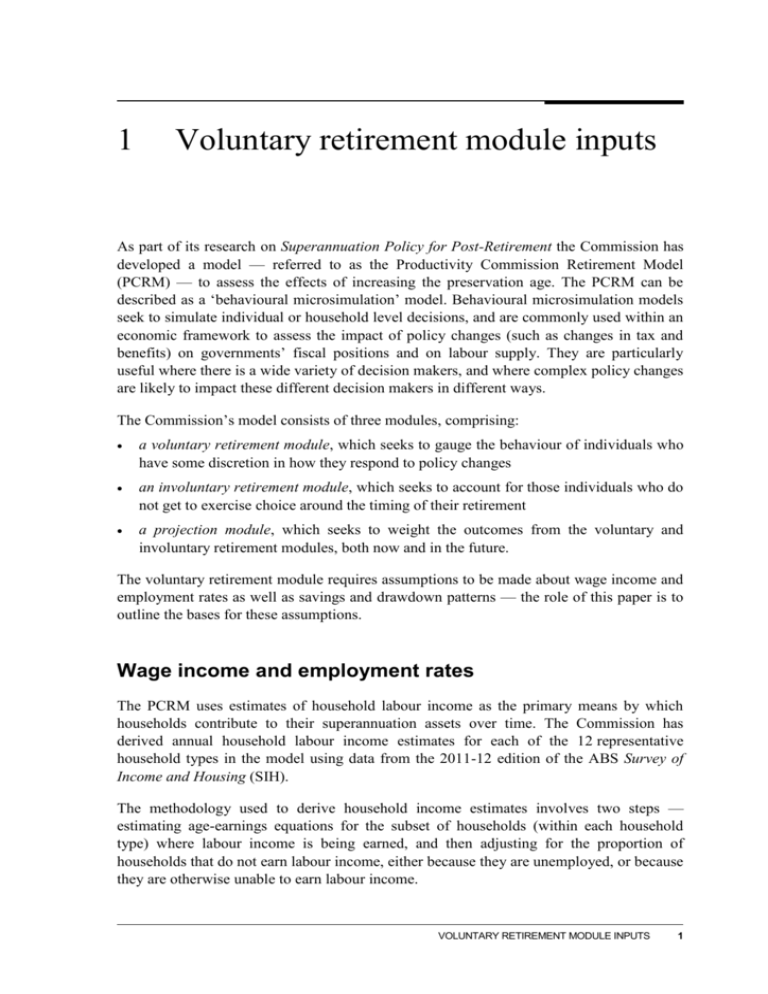1 Voluntary retirement module inputs
advertisement

1 Voluntary retirement module inputs As part of its research on Superannuation Policy for Post-Retirement the Commission has developed a model — referred to as the Productivity Commission Retirement Model (PCRM) — to assess the effects of increasing the preservation age. The PCRM can be described as a ‘behavioural microsimulation’ model. Behavioural microsimulation models seek to simulate individual or household level decisions, and are commonly used within an economic framework to assess the impact of policy changes (such as changes in tax and benefits) on governments’ fiscal positions and on labour supply. They are particularly useful where there is a wide variety of decision makers, and where complex policy changes are likely to impact these different decision makers in different ways. The Commission’s model consists of three modules, comprising: a voluntary retirement module, which seeks to gauge the behaviour of individuals who have some discretion in how they respond to policy changes an involuntary retirement module, which seeks to account for those individuals who do not get to exercise choice around the timing of their retirement a projection module, which seeks to weight the outcomes from the voluntary and involuntary retirement modules, both now and in the future. The voluntary retirement module requires assumptions to be made about wage income and employment rates as well as savings and drawdown patterns — the role of this paper is to outline the bases for these assumptions. Wage income and employment rates The PCRM uses estimates of household labour income as the primary means by which households contribute to their superannuation assets over time. The Commission has derived annual household labour income estimates for each of the 12 representative household types in the model using data from the 2011-12 edition of the ABS Survey of Income and Housing (SIH). The methodology used to derive household income estimates involves two steps — estimating age-earnings equations for the subset of households (within each household type) where labour income is being earned, and then adjusting for the proportion of households that do not earn labour income, either because they are unemployed, or because they are otherwise unable to earn labour income. VOLUNTARY RETIREMENT MODULE INPUTS 1 Age-earnings equations Age-earnings equations are estimated for each of the 12 household types by regressing the relevant household members’ weekly labour income against their age and their age squared. The underlying hypothesis is that an individual’s weekly earnings typically increases with age (as workers develop skills and experience and are paid more per hour), but then declines as they enter older age cohorts. Only individuals that earned income from wages and salaries in 2011-12 are included in the regressions — individuals that were unemployed or did not earn wage and salary income for other reasons were excluded. A summary of the regression results is included in table 1.1, and some examples of the resulting age-earnings equations are illustrated in figure 1.1. Table 1.1 Age-earnings regression resultsa Intercept Age Age squared Single females Lowest wealth quartile 745 (1.9) -2.2 -(0.1) -0.02 -(0.1) 17 (0.1) 39.8 (2.7) -0.45 -(2.7) Second highest wealth quartile -100 -(0.3) 56.1 (3.4) -0.65 -(3.6) Highest wealth quartile -681 -(1.3) 93.5 (3.8) -1.07 -(4.0) Second lowest wealth quartile Single males (1.1) 17.1 (0.7) -0.25 -(0.9) Second lowest wealth quartile -112 -(0.2) 72.3 (2.6) -0.87 -(2.9) Second highest wealth quartile -128 -(0.3) 75.4 (3.3) -0.90 -(3.6) Highest wealth quartile -933 -(1.3) 110.4 (3.6) -1.11 -(3.4) Lowest wealth quartile -144 -(0.6) 65.5 (6.0) -0.79 -(6.5) Second lowest wealth quartile -630 -(2.1) 99.5 (7.2) -1.16 -(7.6) -249 -(0.7) 92.0 (6.0) -1.08 -(6.5) -1 726 -(2.8) 180.8 (6.5) -2.03 -(6.7) 0.8 (0.1) -0.03 -(0.3) -1.2 -(0.1) -0.02 -(0.2) Lowest wealth quartile 608 Couples: High income earner Second highest wealth quartile Highest wealth quartile Couples: Lower income earner Lowest wealth quartile 724 (3.5) Second lowest wealth quartile 879 (4.0) 1 012 (4.5) -2.0 -(0.2) -0.05 -(0.4) 63 (0.2) 50.6 -0.61 -(3.2) Second highest wealth quartile Highest wealth quartile (3.1) a t-values are in parenthesis. Commission estimates based on ABS (Survey of Income and Housing, 2011-12, Cat. no. 6553.0, Basic CURF). 2 SUPERANNUATION POLICY FOR POST-RETIREMENT: MODELLING SUPPLEMENT In general, the results indicate that earnings tend to rise with age initially, but then decline with age once individuals reach their mid-40s. Individuals who head higher wealth households earn more than individuals who head lower wealth households, and males earn more than females (for a given wealth quartile). A few wage profiles were slightly altered to improve the behaviour of representative households.1 These alterations involved marginally strengthening the decline in wage earnings at older ages. Figure 1.1 Examples of age-earnings functions 2000 $ per week 1500 1000 500 0 26.5 32 37 42 47 52 Age in years 57 62 67 62 67 Males in couples: second highest wealth quartile $ per week 2000 0 Single males: second highest wealth quartile 26.5 32 Single wealth 37females:42second highest 47 52 quartile 57 a The earnings functions are derived from individuals in the ABS Survey of Income and Housing that earned wage or salary income in 2011-12. Commission estimates based on ABS (Survey of Income and Housing, 2011-12, Cat. no. 6553.0, Basic CURF). 1 Some households have earnings equations that decrease at a relatively slow rate for older ages. Without adjustment, and given the assumption that all households have the same utility function parameters, this results in these households always retiring at an old age (around 75). This was corrected by marginally strengthening the decline in wage earnings at older ages for these households. VOLUNTARY RETIREMENT MODULE INPUTS 3 Employment rates Not all households are headed by individuals that are employed and contributing to superannuation savings. Hence the earnings per representative household suggested by the age-earnings equations shown in table 1.1 (which are calculated only for the subset of working households) need to be adjusted to take account of this effect. The share of working households within each representative type was calculated for each age group in each of the 12 household types. Note that the share of working households was lowest amongst the lower wealth quartiles, but was typically higher in all other quartiles, particularly for men.2 Estimates of average weekly household wage income in each representative household type were then derived by taking the estimated average weekly earnings for working households of this type (as per the earnings equations in table 1.1) and multiplying them by the estimated proportions of working households of that age and type (figure 1.1). Savings and draw down The savings and drawdown parameters are principally sourced from the ABS’ SIH Basic CURF file for 2011-12, and the ATO’s 2011-12 individuals sample file. While both of these data sources are cross-sectional in nature, drawdown and savings rates are calculated by comparing averages between adjacent age categories for similar household types.3 Longitudinal data would be preferable to make these calculations, however the only other available longitudinal data set, the Household Income and Labour Dynamics in Australia (HILDA) survey, has insufficient observations to be useful when ‘spread across’ twelve household types and 13 age range categories, and only provides information relating to wealth stocks every four years. The parameters derived from the different data sources are summarised in table 1.2. 2 The share of households was smoothed using a Hodrick-Prescott filter with λ equal to 6.25. The share of working households was quite volatile across age groups for a few households. The average share was used for these households rather than the raw data. 3 Savings rates, drawdown rates and initial savings balances were smoothed using a Hodrick-Prescott filter with λ equal to 6.25. 4 SUPERANNUATION POLICY FOR POST-RETIREMENT: MODELLING SUPPLEMENT Table 1.2 Savings and drawdown data sources and notes Parametera Source Notes Salary sacrifice as a share ATO 2% income tax return Calculated based on income test item ‘reportable employer superannuation contributions’ and income item of wage income ‘salary/wage amount’. Salary sacrifice rates for those on transition to retirement pensions (TTR pensions) are sample file for 2011-12 b derived in the same way for the subset of observations where receipt of ‘Australian annuity or superannuation income stream’ (either taxed or untaxed) and ‘wage income’ occurs. Additional superannuation ABS SIH 2011-12 Basic contributions outside of CURF, household and salary sacrifice person files; unpublished ATO and superannuation fund data Unpublished data from income tax returns and member contribution statements were used to derive the proportion of post-tax contributions into superannuation as a share of post-tax income for different income ranges by single males, single females and couples. The resulting contribution rates were then matched to the household types used in the model by comparing the corresponding after-tax income ranges in the SIH. Drawdown rates in general ABS SIH 2011-12 Basic CURF, Household file Calculated as the average annual percentage difference between age categories for the average value of non-superannuation assets, and the average value of superannuation assets. c Restricted to negative values. Restricted to ages 55 and above for post-retirement rates. Restricted to ages less than 55 for pre-retirement drawdown values. Savings rates in general ABS SIH 2011-12 Basic CURF, Household file Calculated as the average annual difference between age categories for the average value of non-superannuation assets, and the average value of superannuation assets, as a share of annualised disposable income. Restricted to positive values to calculate savings rates. Drawdown rates from TTR ABS SIH 2011-12 Basic pensions arrangements CURF, household and person files Calculated by identifying those using TTR pensions (simultaneous receipt of superannuation income and wage income), and taking the ratio of this income as a share of total superannuation balances. Assets in base year Average non-superannuation assets and superannuation assets. ABS SIH 2011-12 Basic CURF, Household file a Calculated for each household-type in each age range category. b Household types are proxied when using ATO data by their couple status and total income, as opposed to wealth, as ATO data contains no information on assets or liabilities. c Non-superannuation assets are defined as all asset categories except superannuation and the primary dwelling less the total liabilities on all assets apart from the primary dwelling. Superannuation assets are defined as the sum of government and non-government superannuation accounts. VOLUNTARY RETIREMENT MODULE INPUTS 5







